Discovery of BI-2493, a Pan-KRAS Inhibitor Showing In Vivo Efficacy
- PMID: 40709733
- PMCID: PMC12362595
- DOI: 10.1021/acs.jmedchem.5c00576
Discovery of BI-2493, a Pan-KRAS Inhibitor Showing In Vivo Efficacy
Abstract
KRAS is one of the most highly validated cancer targets. Here we describe the design and synthesis of two reversible pan-KRAS inhibitors, BI-2865 and BI-2493. From our KRASG12C inhibitor program, we identified BI-2865, a potent noncovalent KRAS inhibitor that showed cellular activity against a broad spectrum of KRAS alleles and selectivity against HRAS and NRAS. Spirocyclization led to the discovery of BI-2493, a highly rigid analogue exhibiting better potency, metabolic stability, and permeability. BI-2493 shows in vivo efficacy in various KRAS mutant and KRAS wild-type amplified xenograft models and represents a promising starting point for further optimization.
Figures
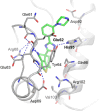
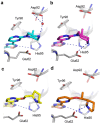
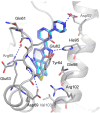





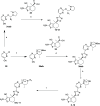

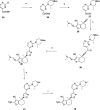



References
-
- Kim D., Herdeis L., Rudolph D., Zhao Y., Böttcher J., Vides A., Ayala-Santos C. I., Pourfarjam Y., Cuevas-Navarro A., Xue J. Y., Mantoulidis A., Bröker J., Wunberg T., Schaaf O., Popow J., Wolkerstorfer B., Kropatsch K. G., Qu R., de Stanchina E., Sang B., Li C., McConnell D. B., Kraut N., Lito P.. Pan-KRAS Inhibitor Disables Oncogenic Signalling and Tumour Growth. Nature. 2023;619:160–166. doi: 10.1038/s41586-023-06123-3. - DOI - PMC - PubMed
-
- Maurer T., Garrenton L. S., Oh A., Pitts K., Anderson D. J., Skelton N. J., Fauber B. P., Pan B., Malek S., Stokoe D., Ludlam M. J. C., Bowman K. K., Wu J., Giannetti A. M., Starovasnik M. A., Mellman I., Jackson P. K., Rudolph J., Wang W., Fang G.. Small-Molecule Ligands Bind to a Distinct Pocket in Ras and Inhibit SOS-Mediated Nucleotide Exchange Activity. Proc. Natl. Acad. Sci. U.S.A. 2012;109(14):5299–5304. doi: 10.1073/pnas.1116510109. - DOI - PMC - PubMed
-
- Kessler D., Gmachl M., Mantoulidis A., Martin L. J., Zoephel A., Mayer M., Gollner A., Covini D., Fischer S., Gerstberger T., Gmaschitz T., Goodwin C., Greb P., Häring D., Hela W., Hoffmann J., Karolyi-Oezguer J., Knesl P., Kornigg S., Koegl M., Kousek R., Lamarre L., Moser F., Munico-Martinez S., Peinsipp C., Phan J., Rinnenthal J., Sai J., Salamon C., Scherbantin Y., Schipany K., Schnitzer R., Schrenk A., Sharps B., Siszler G., Sun Q., Waterson A., Wolkerstorfer B., Zeeb M., Pearson M., Fesik S. W., McConnell D. B.. Drugging an Undruggable Pocket on KRAS. Proc. Natl. Acad. Sci. U.S.A. 2019;116(32):15823–15829. doi: 10.1073/pnas.1904529116. - DOI - PMC - PubMed
MeSH terms
Substances
Grants and funding
LinkOut - more resources
Full Text Sources
Research Materials
Miscellaneous

